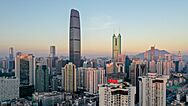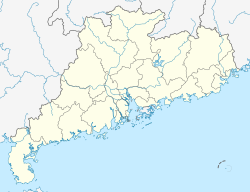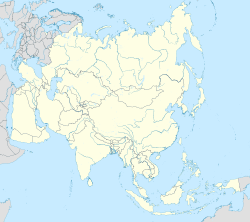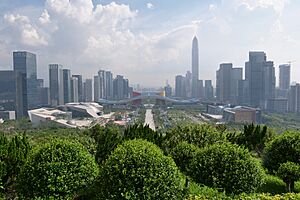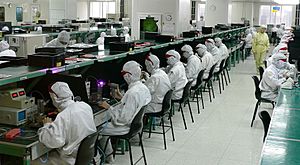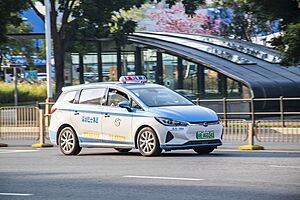Shenzhen facts for kids
Quick facts for kids
Shenzhen
深圳市
|
|
|---|---|
|
Prefecture-level and sub-provincial city
|
|
|
From top, left to right: Aerial view of Futian CBD; KK100 and Shun Hing Square; Huaqiangbei; Shennan Boulevard over Huaqiangbei; the Shenzhen Bay
|
|
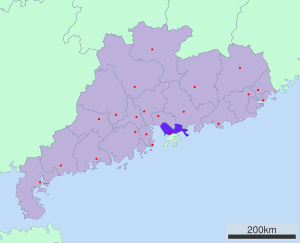
Location of Shenzhen City jurisdiction in Guangdong
|
|
| Country | |
| Province | Guangdong |
| County-level divisions | 9 |
| Settled | 331 |
| Village | 1953 |
| City | 23 January 1979 |
| SEZ formed | 1 May 1980 |
| Municipal seat | Futian District |
| Government | |
| • Type | Sub-provincial city |
| • Body | Shenzhen Municipal People's Congress |
| Area | |
| • Prefecture-level and sub-provincial city | 1,986 km2 (767 sq mi) |
| • Urban | 1,748 km2 (675 sq mi) |
| Elevation | 0–943.7 m (0–3,145.7 ft) |
| Population
(2020)
|
|
| • Prefecture-level and sub-provincial city | 17,560,000 |
| • Density | 8,842/km2 (22,900/sq mi) |
| • Urban
(2021)
|
14,678,000 |
| • Urban density | 8,397.0/km2 (21,748/sq mi) |
| • Metro
(2010)
|
23,300,000 |
| • Major ethnicities | Han |
| GDP (2023) | |
| • Prefecture-level and sub-provincial city | CN¥ 3.461 trillion US$ 491 billion |
| • Per capita | CN¥ 195,230 US$ 27,705 |
| Time zone | UTC+8 (China Standard) |
| Postal code |
518000
|
| Area code(s) | 755 |
| ISO 3166 code | CN-GD-03 |
| Licence plate prefixes | 粤B |
| City flower | Bougainvillea |
| City trees | Lychee and Mangrove |
| Website | |
| Shenzhen | |||||||||||||||||||||||||||||||||||||||||||||||
|---|---|---|---|---|---|---|---|---|---|---|---|---|---|---|---|---|---|---|---|---|---|---|---|---|---|---|---|---|---|---|---|---|---|---|---|---|---|---|---|---|---|---|---|---|---|---|---|

"Shenzhen" in Chinese characters
|
|||||||||||||||||||||||||||||||||||||||||||||||
| Chinese | 深圳 | ||||||||||||||||||||||||||||||||||||||||||||||
| Hanyu Pinyin | Shēnzhèn | ||||||||||||||||||||||||||||||||||||||||||||||
| Cantonese Yale | Sāmjan | ||||||||||||||||||||||||||||||||||||||||||||||
| Postal | Shamchun | ||||||||||||||||||||||||||||||||||||||||||||||
| Literal meaning | "Deep Drainage" | ||||||||||||||||||||||||||||||||||||||||||||||
|
|||||||||||||||||||||||||||||||||||||||||||||||
Shenzhen is a big city in Guangdong, China. It's a special economic zone, which means it has different rules to help its economy grow. The city is on the east side of the Pearl River near the coast. It borders Hong Kong to the south.
Shenzhen was once a small village. It became a city in 1979. In the early 1980s, China started new economic plans. Shenzhen became the first special economic zone because it was close to Hong Kong. This helped it attract money from other countries and many people looking for jobs.
In just 30 years, Shenzhen grew very fast. Its economy and population boomed. Now, it's a major center for technology, global trade, and money matters. Shenzhen is home to the Shenzhen Stock Exchange, one of the biggest stock markets in the world. It's also a "global first-tier" city.
Shenzhen's economy is now one of the top ten largest in the world. It has the eighth most important financial center globally. Many big companies from the Fortune Global 500 list have their main offices here. Shenzhen also has the second-highest number of skyscrapers in the world.
The city is a top global technology hub. Some people call it China's Silicon Valley. Many small and large tech companies like Huawei, Tencent, and DJI started here. Shenzhen hosts many international events, like the 2011 Summer Universiade. A lot of people living in Shenzhen have moved there from other parts of China. This means the city has a younger population than most places in China.
Contents
- What's in a Name?
- City History
- City Location and Weather
- Shenzhen's Economy
- Main Industries
- Fun Things to Do
- People and Culture
- City Look
- Learning and Research
- Getting Around
- City Life and Fun
- Sports and Recreation
- Environment and Nature
- Media in Shenzhen
- Shenzhen and Hong Kong
- Sister Cities
- See also
What's in a Name?
The name Shenzhen was first written down around 1410. This was during the Ming dynasty. Local people called the drains in their rice fields "Zhen" (Chinese: 圳; literally "ditch, drain"). Shenzhen got its name from a "deep" (Chinese: 深; literally "deep") drain in the area.
City History
Early Times to Ming Dynasty
People have lived in the Shenzhen area for about 6,700 years. The oldest signs of humans here are from the middle Neolithic period. Important towns like Nantou and Dapeng were built over 600 years ago. The Hakka people also came to Shenzhen about 300 years ago.
Around 214 BC, Emperor Qin Shi Huang united China. The Shenzhen area became part of the Nanhai Commandery. This helped bring the culture of central China here. Later, in 331 AD, a new area called Dongguan Commandery was created. Its main town was near modern Nantou.
During the Song dynasty, Nantou became a key trading spot. It was important for salt and spices in the South China Sea. In the Yuan dynasty, the area was known for producing pearls. In the early Ming dynasty, Chinese sailors would visit a temple in Chiwan to pray before sailing to Southeast Asia. A big naval battle against the Portuguese happened south of Nantou.
From Qing Dynasty to the 1940s
To stop rebellions, the Qing dynasty moved people away from the coast. This changed the size of Bao'an County. After the Opium Wars, parts of Bao'an County became part of British Hong Kong. The village of Shenzhen was right next to this new border.
In 1911, the Chinese part of the Kowloon–Canton Railway (KCR) opened. Shenzhen railway station was the last stop on the Chinese side. This helped Shenzhen's economy and connected it to the world. In 1913, Bao'an County was renamed Shenzhen to avoid confusion with another county.
During World War II, the Japanese army took over Shenzhen. The Bao'an County government had to move. In 1941, the Japanese tried to cross into Hong Kong. But the British blew up the Lo Wu Bridge in Shenzhen, stopping them.
From the 1950s to 1975
In 1953, the Bao'an County government moved to Shenzhen. Shenzhen was closer to the railway and had a stronger economy. From the 1950s to the late 1970s, many people moved to Shenzhen. They were trying to reach Hong Kong.
In 1978, officials looked into making a foreign trade port in Bao'an County. They suggested turning Bao'an County and Zhuhai into places for exporting goods. On January 23, 1979, Bao'an County was officially renamed Shenzhen. It was approved by the government.
On January 31, 1979, the government approved a plan for the Shekou Industrial Zone in Shenzhen. This zone was meant to help with trade and industry. It was based on how Hong Kong and Macau worked. This made Shekou the first industrial zone in mainland China for exports.
In April 1979, officials suggested creating "trade cooperation zones" in Shenzhen, Zhuhai, and Shantou. The government agreed to try out the first special economic zones (SEZ) in these cities. In November, Shenzhen became a major city at the regional level.
Special Economic Zone (1980s–Present)
In 1980, Shenzhen had only 30,000 people. In May 1980, Shenzhen was chosen as China's first SEZ. This was part of China's plan to open up its economy. The idea was to test out market capitalism while keeping Chinese socialist ideas.
In March 1981, Shenzhen became an even more important city. There were plans for Shenzhen to have its own money. But these plans were stopped. In 1983, the Shenzhen government put up fences and checkpoints. This was to control who came into the special economic zone.
In December 1990, the Shenzhen Stock Exchange was created. This was a place for buying and selling stocks. By 2001, more people from mainland China chose to live in Shenzhen. They stayed there instead of trying to cross into Hong Kong illegally.
On July 1, 2010, the special economic zone was made much larger. It now included all of Shenzhen's districts. In August 2011, Shenzhen hosted the 2011 Summer Universiade. This is a big sports event for university athletes. In April 2015, the Shekou Industrial Zone became part of the new Guangdong Free-Trade Zone.
In August 2019, the Chinese government in Beijing announced new plans for Shenzhen. They called Shenzhen a "pilot demonstration zone" for Chinese socialism. This means Shenzhen will try out new ideas for its economy and society.
City Location and Weather
Geography
| Weather chart for Shenzhen | |||||||||||||||||||||||||||||||||||||||||||||||
|---|---|---|---|---|---|---|---|---|---|---|---|---|---|---|---|---|---|---|---|---|---|---|---|---|---|---|---|---|---|---|---|---|---|---|---|---|---|---|---|---|---|---|---|---|---|---|---|
| J | F | M | A | M | J | J | A | S | O | N | D | ||||||||||||||||||||||||||||||||||||
|
26
20
13
|
48
20
14
|
70
23
17
|
154
26
20
|
237
30
24
|
347
31
26
|
320
32
26
|
354
32
26
|
254
31
25
|
63
29
23
|
35
25
18
|
27
22
14
|
||||||||||||||||||||||||||||||||||||
| temperatures in °C precipitation totals in mm source: Shenzhen Meteorological Bureau 1981–2010 normals |
|||||||||||||||||||||||||||||||||||||||||||||||
|
Imperial conversion
|
|||||||||||||||||||||||||||||||||||||||||||||||
Shenzhen is located in the Pearl River Delta. It borders Hong Kong to the south. To the north and northeast is Huizhou. Dongguan is to the north and northwest. The city is about 100 kilometers southeast of Guangzhou.
As of 2017, Shenzhen had over 12.5 million people living there. The city is long and narrow. It measures 81.4 kilometers from east to west. The shortest distance from north to south is 10.8 kilometers.
More than 160 rivers and channels flow through Shenzhen. There are also 24 reservoirs. These hold a total of 525 million tonnes of water. Important rivers include the Shenzhen River and Maozhou River.
Climate
Shenzhen has a warm, humid subtropical climate. This means it has hot, rainy summers and mild, dry winters. Frost is very rare here. Fog is common in winter and spring. The rainy season starts in April and lasts until October.
The city gets a lot of rain in summer. It can also be very humid and hot. But extremely hot days are rare. Shenzhen gets about 1,853 hours of sunshine each year. Heavy rains and typhoons can happen in summer and early autumn. The lowest temperature ever recorded was 0.2°C. The highest was 38.7°C.
| Climate data for Shenzhen (1991–2020, extremes 1951-present) | |||||||||||||
|---|---|---|---|---|---|---|---|---|---|---|---|---|---|
| Month | Jan | Feb | Mar | Apr | May | Jun | Jul | Aug | Sep | Oct | Nov | Dec | Year |
| Record high °C (°F) | 29.1 (84.4) |
28.9 (84.0) |
32.0 (89.6) |
34.0 (93.2) |
36.8 (98.2) |
36.9 (98.4) |
38.7 (101.7) |
37.1 (98.8) |
36.9 (98.4) |
35.2 (95.4) |
33.1 (91.6) |
29.8 (85.6) |
38.7 (101.7) |
| Mean daily maximum °C (°F) | 19.8 (67.6) |
20.8 (69.4) |
23.2 (73.8) |
26.7 (80.1) |
29.7 (85.5) |
31.3 (88.3) |
32.3 (90.1) |
32.2 (90.0) |
31.5 (88.7) |
29.2 (84.6) |
25.7 (78.3) |
21.5 (70.7) |
27.0 (80.6) |
| Daily mean °C (°F) | 15.7 (60.3) |
16.8 (62.2) |
19.4 (66.9) |
23.1 (73.6) |
26.4 (79.5) |
28.3 (82.9) |
29.0 (84.2) |
28.8 (83.8) |
27.9 (82.2) |
25.5 (77.9) |
21.7 (71.1) |
17.4 (63.3) |
23.3 (74.0) |
| Mean daily minimum °C (°F) | 13.0 (55.4) |
14.2 (57.6) |
17.0 (62.6) |
20.7 (69.3) |
24.0 (75.2) |
26.0 (78.8) |
26.6 (79.9) |
26.3 (79.3) |
25.5 (77.9) |
22.9 (73.2) |
19.0 (66.2) |
14.5 (58.1) |
20.8 (69.5) |
| Record low °C (°F) | 0.9 (33.6) |
0.2 (32.4) |
3.4 (38.1) |
8.7 (47.7) |
14.8 (58.6) |
19.0 (66.2) |
20.0 (68.0) |
21.1 (70.0) |
16.9 (62.4) |
9.3 (48.7) |
4.9 (40.8) |
1.7 (35.1) |
0.2 (32.4) |
| Average rainfall mm (inches) | 35.2 (1.39) |
36.8 (1.45) |
64.0 (2.52) |
140.1 (5.52) |
237.1 (9.33) |
368.7 (14.52) |
309.5 (12.19) |
364.3 (14.34) |
242.5 (9.55) |
73.4 (2.89) |
31.7 (1.25) |
29.6 (1.17) |
1,932.9 (76.12) |
| Average rainy days (≥ 0.1 mm) | 5.5 | 7.8 | 9.9 | 11.4 | 14.3 | 18.4 | 17.2 | 16.7 | 13.2 | 5.9 | 4.6 | 5.2 | 130.1 |
| Average relative humidity (%) | 68 | 74 | 77 | 79 | 79 | 80 | 79 | 79 | 75 | 67 | 67 | 64 | 74 |
| Mean monthly sunshine hours | 137.3 | 101.6 | 99.7 | 115.2 | 153.0 | 169.8 | 214.8 | 178.6 | 170.1 | 188.7 | 168.8 | 155.4 | 1,853 |
| Percent possible sunshine | 40 | 31 | 27 | 30 | 37 | 42 | 52 | 45 | 47 | 53 | 51 | 47 | 42 |
| Source 1: Shenzhen Meteorological Bureau | |||||||||||||
| Source 2: CMA | |||||||||||||
Shenzhen's Economy
Shenzhen was the first Special Economic Zone (SEZ) in China. This was a plan to help the city grow its economy. It aimed to bring in new technology and business ideas. By 2022, Shenzhen's economy was the third largest among Chinese cities. It was bigger than nearby Hong Kong and Guangzhou.
Shenzhen is a top financial center in the world. In 2021, it was ranked 8th globally. It's also seen as a "global first-tier" city. This means it's a very important city worldwide. According to Forbes, Shenzhen has the fifth-highest number of billionaires.
Shenzhen is part of the "21st Century Maritime Silk Road." This is a big trade route that connects China to other parts of the world. As of August 2023, Shenzhen has the seventh-most headquarters of Fortune Global 500 companies. These are some of the biggest companies in the world.
Main Industries
Shenzhen's economy is built on four main industries. These are high-tech, finance, logistics (moving goods), and culture.
High-Tech Industry

Shenzhen is a huge center for technology in China and worldwide. It's a great place for new tech companies to start. In 2020, it was ranked as the 4th best city for financial technology (Fintech). Shenzhen is famous for its high-tech industry. This industry made up a big part of the city's economy in 2015.
Many famous tech companies are based in Shenzhen. These include Huawei, Tencent, DJI, and ZTE. Other tech companies like Hasee (computers) and OnePlus (phones) are also here.
Every year, Shenzhen hosts the China International High-tech Achievements Fair. This event shows off new tech products. It also helps tech companies find investors. Because of this, Shenzhen is sometimes called "China's Silicon Valley."
Financial Services
Shenzhen has many large financial companies. Examples include China Merchants Bank and Ping An Insurance. Many foreign banks have also opened offices here. These include Citibank and HSBC.
The financial industry is a big part of Shenzhen's economy. By the end of 2016, Shenzhen's financial industry was the third largest in China. It's one of the world's top ten financial centers. This is because it's good for business, has skilled workers, and good transport.
Container Port
Companies like SF Express and China International Marine Containers have their main offices in Shenzhen. The Port of Shenzhen is made up of several large container terminals. These include Yantian and Shekou. The Port of Shenzhen can handle a huge amount of cargo.
In 2005, it was the world's fourth-busiest container port. This is because of the high amount of trade. Shenzhen is a major "port megacity." The logistics industry, which moves goods, is also a big part of the city's economy. Shenzhen Port recently launched a new system to release cargo using blockchain technology.
Cultural Industry
Shenzhen wants to grow its cultural industry. This includes fashion, design, and animation. In 2008, UNESCO named Shenzhen a "United Nations Design Capital." This means it's recognized for its creative design.
The cultural industry makes up a good part of Shenzhen's economy. Shenzhen is known for making handicrafts. It's also a center for oil painting, especially in Dafen Village. Shenzhen hosts the International Cultural Fair every year. This event showcases cultural industries from around the world.
Real Estate
Shenzhen also has a big real estate industry. This industry builds and sells homes and buildings. It adds a lot to Shenzhen's economy. Big real estate companies like Evergrande Group and Vanke are based here.
High-Tech Industrial Development Zone
In 1996, the government created the Shenzhen High-tech Industrial Development Zone. This zone helps grow Shenzhen's high-tech industry. It focuses on electronics and information technology. The Shenzhen Software Park is also part of this zone.
In 2010, the government approved a plan to strengthen ties between Hong Kong and Shenzhen. This plan created the Qianhai Shenzhen-Hong Kong Modern Service Industry Cooperation Zone. It's a free-trade zone that helps businesses from both cities.
Fun Things to Do
Tourism
Tourism is becoming a very important industry in Shenzhen. Lonely Planet even ranked Shenzhen as one of the top 10 cities to visit in 2019. The city wants to become a global tourist hub. It focuses on its science, fashion, and industrial side.
Shenzhen has many tourist spots. These include theme parks, public parks, and tall buildings. Many attractions are part of Overseas Chinese Town (OCT). This includes places like the Window of the World and Splendid China Folk Village. Other popular spots are Happy Valley and OCT East.
Shenzhen also has many public parks and beaches. Some famous ones are People's Park and Lianhuashan Park. You can also visit Dameisha and Xiaomeisha beaches. The city is home to very tall buildings. These include the Ping An Finance Centre and KK100.
As of 2022, Shenzhen has 314 hotels with star ratings. Many international luxury hotels are here. These include Mandarin Oriental and Park Hyatt. There are also hotels in key business areas and beach resorts. The St. Regis Hotels & Resorts is located in the top part of the KK100 skyscraper.
Shenzhen's tourism is growing fast. The city plans to have 150 million tourists by 2020. In 2023, many people from Hong Kong started visiting Shenzhen on weekends. This shows how popular the city is becoming.
Shopping
Shopping is a big part of Shenzhen's economy. It makes up a large portion of the city's service industry. Many foreign investments also go into wholesale and retail.
Huaqiang North is a famous shopping area. It's known for having one of the biggest electronics markets in the world. Luohu Commercial City is another popular spot. It's next to the Shenzhen railway station. You can find many different products there.
Shenzhen has many shopping malls and commercial areas. These include COCO Park and Uniworld. "Smart retail" is also growing in Shenzhen. This uses technology like artificial intelligence to improve shopping. The city wants to become a "new retail" hub.
People and Culture
Demographics
| Historical populations of Shenzhen in the National Census | ||
|---|---|---|
| Year | Pop. | ±% p.a. |
| 1982 | 351,900 | — |
| 1990 | 1,667,400 | +21.47% |
| 2000 | 7,008,400 | +15.44% |
| 2010 | 10,424,000 | +4.05% |
| 2015 | 11,378,700 | +1.77% |
| 2016 | 11,908,400 | +4.66% |
| 2017 | 12,528,300 | +5.21% |
| 2018 | 13,026,600 | +3.98% |
| 2019 | 13,438,800 | +3.16% |
| 2020 | 17,560,100 | +30.67% |
In 2020, Shenzhen had over 17.5 million people living there. Shenzhen is a young city. Only about 5.36 percent of its people are over 60 years old. The average life expectancy in Shenzhen is 81.25 years. This is one of the highest in China.
Before Shenzhen became a special economic zone, most people were Hakka and Cantonese. After 1980, many people moved to Shenzhen from all over China. They came from different provinces like Hunan and Sichuan. Many of these new residents live in special areas called chengzhongcun, which means "villages in the city."
Shenzhen also has a noticeable Korean community. These are people who moved to Shenzhen to work for South Korean companies. Because so many people moved to Shenzhen, the city has made it harder to get a local resident permit.
Religion
The main religions in Shenzhen are Buddhism and Taoism. You can find Protestant and Catholic churches in every district. There are also mosques. A survey in 2010 showed that many people in Shenzhen follow Chinese folk religions. Others are Buddhist, Taoist, Christian, or Muslim.
Languages
Before Shenzhen became a special economic zone, people spoke Cantonese and Hakka. These are two different Chinese languages. But now, most people in Shenzhen speak Mandarin. This is because the government promoted Mandarin. Also, many people moved to Shenzhen from other parts of China where Mandarin is spoken.
Even though Mandarin is common, some people in Shenzhen are trying to bring back Cantonese. They want to make it a bigger part of Shenzhen's culture.
City Look
{{Wide image|Civic Center, Shenzhen Lianhuashan Park (2018.9) Night cropped.jpg|880px|A night view of the Shenzhen Civic Center. The Ping An Finance Centre is on the right. This building is in the city's center.]]
In 2019, The Guardian newspaper called Shenzhen "the world leader completing new skyscrapers." Shenzhen has the second-highest number of buildings over 150 meters tall. As of July 2021, it had 297 such buildings. More skyscrapers were built in Shenzhen in 2016 than in the entire US and Australia combined.
Many of Shenzhen's skyscrapers were designed by architects from Hong Kong or other countries. They often use a modern style. Some famous tall buildings include the Guomao Building and the Shun Hing Square. The Ping An Finance Centre is 599 meters tall. It's the second tallest building in China and the fifth tallest in the world. It was built to look unique and show the history of its main tenant, Ping An Insurance.
Shenzhen also has old buildings with traditional Chinese designs. There are Hakka walled villages like Crane Lake. These villages have thick grey walls, narrow paths, and courtyards. Nantou is a historic town. It has some buildings from the Ming dynasty.
Chiwan also has historical buildings. These include the tomb of an old emperor and the Tianhou Temple. There are also old forts that protected the coast. Examples are Dapeng Fortress and Chiwan Left Fort. In 2023, the Marisfrolg Pavilion was finished. It has a unique insect-like design.
Learning and Research
Education in Shenzhen
Before the 1980s, Shenzhen mostly had primary and secondary schools. Not many people went to university. When Shenzhen became a special economic zone, many people moved there. More jobs needed a university education. Shenzhen started to improve its schools. It hired good teachers and updated school buildings.
In the mid-1980s, more people wanted to go to college. Shenzhen University opened in 1983. It was the city's first full-time university. In 1999, the Shenzhen Virtual University Park was created. Here, top university teachers taught graduate students. Later, the Southern University of Science and Technology opened in 2011. Shenzhen Technology University opened in 2018.
Other famous universities also have campuses in Shenzhen. These include Tsinghua University and Peking University. As of 2023, Shenzhen is ranked 19th in the world for scientific research.
Education for the first nine years is free in Shenzhen. Some secondary schools are very famous. These include Shenzhen Middle School and Shenzhen Experimental School. As of 2015, Shenzhen had 12 universities. It also had many secondary and primary schools, and preschools.
Some people have pointed out that Shenzhen needs more primary and secondary schools. This is because the city's population has grown so much. In response, Shenzhen schools have started to offer higher salaries to attract more teachers.
Getting Around
Shenzhen is a major transport hub in South China. It has a great public transport system. This includes the Shenzhen Metro, buses, and taxis. You can pay with a Shenzhen Tong card or QR codes on your phone. Shenzhen was the first major city to use only electric buses and taxis. As of 2023, 70% of cars in Shenzhen were electric.
For air travel, Shenzhen has its own Shenzhen Bao'an International Airport. It's also close to Hong Kong International Airport. Shenzhen Bao'an International Airport is a main hub for airlines like Shenzhen Airlines. In 2018, it was the 5th busiest airport in China for passengers. You can also take ferries from Shenzhen to Hong Kong International Airport.
The Shenzhen Metro is the city's subway system. In 2022, it had 12 lines and 290 stations. The network is planned to grow even more by 2030. The metro also has a tram system in the Longhua District.
Shenzhen has seven inter-city railway stations. These include Futian and Shenzhen North. High-speed trains connect Shenzhen to other major cities. Regular train lines also pass through Shenzhen.
As of August 2019, Shenzhen's bus system has over 900 lines. It has more than 16,000 electric buses. This is the largest electric bus fleet in the world. By early 2019, almost all taxis in Shenzhen were electric. Electric taxis are blue and white.
Shenzhen is part of China's expressway system. Many expressways run through the city. Shenzhen is also building a bridge across the Pearl River Delta. This bridge will connect Shenzhen to the city of Zhongshan.
You can take ferries from Shenzhen to Hong Kong and Macau. Ferries leave from the Shekou Cruise Center. The Port of Shenzhen is the world's third busiest container port. It handles millions of shipping containers each year.
Shenzhen is very close to Hong Kong. This means it has the most border crossings in China. Millions of people cross the border between Shenzhen and Hong Kong every year. Border crossing points include the Shenzhen Bay Port and Luohu Port.
City Life and Fun
Culture
Shenzhen used to have a Cantonese culture. But now, it's known for its fast-paced, competitive culture. This is called "Shenzhen speed." It refers to how quickly things are built and changed in the city.
In 2003, the city government decided to make Shenzhen a cultural city. They wanted to promote design, animation, and libraries. Shenzhen is also known for being a big manufacturer of handicrafts. It's a center for oil painting, especially in Dafen Village.
Shenzhen hosts the International Cultural Fair. This event shows off cultural industries from all over the world. Because of these efforts, UNESCO gave Shenzhen the title of "United Nations Design Capital."
The city also created the "Library City" plan in 2003. This plan aimed to build a network of libraries. By 2015, Shenzhen had 620 public libraries. Famous libraries include the Shenzhen Library. The Shenzhen Book City is a very large bookstore.
Shenzhen has many museums and art galleries. These include the Shenzhen Museum and the He Xiangning Art Museum. There are also theaters like the Shenzhen Concert Hall.
Shenzhen has a city-wide school uniform for primary and secondary schools. The uniforms are blue and white. They are very well-known and represent Chinese student uniforms.
Food
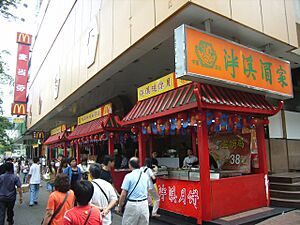
The main type of food in Shenzhen is Cantonese. But because so many people have moved to the city, you can find many different kinds of food. These include Teochew cuisine, Hakka cuisine, and Sichuan cuisine.
The Yantian District is famous for its seafood. You can find many restaurants along the coast. Street food like Xinjiang cuisine can be found in Xijie Street. Shenzhen also has its own tea culture. The first McDonald's in mainland China opened in Shenzhen in 1990. Shenzhen is also home to the Hey Tea chain, which sells popular cheese and fruit teas.
Nightlife
Shenzhen has a lively nightlife. Most of the fun happens in places like COCO Park and Shekou. COCO Park is sometimes called "Shenzhen's answer to Lan Kwai Fong," a famous nightlife area in Hong Kong. There are many bars and clubs that stay open late.
Sports and Recreation
Sports
Shenzhen has several professional sports teams. These include the Shenzhen Leopards (basketball) and Shenzhen Peng City F.C. (soccer).
Shenzhen hosts many international sports events. In 2011, it hosted the 2011 Summer Universiade. This is a big sports event for university students. Shenzhen also hosted a National Hockey League game in 2018. From 2019 to 2028, Shenzhen is hosting the WTA Finals tennis tournament. It was also one of the host cities for the 2019 FIBA Basketball World Cup.
Shenzhen is a popular place for skateboarders. This is because of the city's buildings and relaxed rules for skating. Shenzhen has several sports venues. Shenzhen Stadium was once home to the Shenzhen F.C. soccer team. For the 2011 Summer Universiade, new venues were built. These include the Shenzhen Bay Sports Center.
One unique sports event in Shenzhen is RoboMaster. This is a robot competition for university students. It's hosted by DJI. Teams of robots battle each other. The winners get prize money and job offers at DJI.
Environment and Nature
Parks and Beaches
Shenzhen has a large system of public parks. By 2019, the city had 1,090 parks. These included natural parks, urban parks, and community parks. Shenzhen plans to build and improve over 40 parks each year. The goal is to have 1,500 parks by 2035.
Lianhuashan Park is a big park in the Futian District. At the top of the mountain, there is a large bronze statue of Deng Xiaoping. Wutongshan National Park is around the mountain of the same name. From here, you can see the Shenzhen skyline and Hong Kong.
Shenzhen Bay Park opened in 2011. It's along the city's coastline. It includes the Mangrove Park. This park has different recreation areas and a long path along the coast. The Mangrove Ecopark is home to many birds.
Shenzhen also has several beaches. These include Dameisha and Xiaomeisha in the Yantian District. Other beaches are Jinshawan and Xichong.
Pollution and Protection
During the COVID-19 pandemic, Shenzhen had good air quality. It had some of the lowest pollution levels among Chinese mega-cities. Most of Shenzhen's pollution comes from factories, using coal, and traffic.
In 2014, Shenzhen had serious water pollution in its rivers. Many rivers were in "critical" condition. The city started a big project to clean up its rivers. They built more water pipes and sewage treatment plants.
From 2000 to 2014, Shenzhen spent a lot of money to clean its rivers. They built many sewage treatment plants and laid thousands of kilometers of pipes. By 2020, they added even more water pipelines.
In 2009, Shenzhen was chosen to test a new energy vehicle program. In 2017, Shenzhen offered money to help with electric buses. By mid-2018, Shenzhen was the first city to have only electric public buses. By early 2019, almost all taxis were electric.
In late 2019, Shenzhen started a garbage sorting program. Residents have to sort their trash into four types. People who follow the rules can get money. Those who don't might get fined.
Media in Shenzhen
Shenzhen has many newspapers and publishing houses. It also has many branches of media companies from China and Hong Kong. The main media companies are Shenzhen Media Group and Shenzhen Press Group.
Shenzhen News is a Chinese newspaper. It's Shenzhen's main online news source. Shenzhen Daily is an English newspaper. It covers local and international news. ShekouDaily.com is an online news source for the Shekou area.
Shenzhen and Hong Kong
Shenzhen and Hong Kong used to be part of the same area. After a war, Hong Kong became British territory. This created the border between Hong Kong and Shenzhen. The two cities are separated by two bays and a river.
Shenzhen and Hong Kong have a close relationship. They are very near each other. They also have similar economic systems. From 1980 to 2007, Hong Kong was Shenzhen's biggest trade partner. In 2015, trade between them was very high.
Both cities created the Qianhai Shenzhen-Hong Kong Modern Service Industries Cooperation Zone. This is a free-trade zone. It helps bring Hong Kong and mainland China closer. As of 2021, many Hong Kong companies have offices in Qianhai.
As of 2016, there are nine ways to cross the border between Shenzhen and Hong Kong. Six of these are land crossings. These include the Shenzhen Bay Port and Luohu Port. You can cross by road or train at these points.
Sister Cities
Shenzhen has many sister city relationships around the world. In 1989, Houston in the United States became Shenzhen's first sister city. As of 2015, Shenzhen has sister city ties with 25 cities.
As of May 2021, Shenzhen is connected with these cities and regions:
 Houston, United States, March 1986
Houston, United States, March 1986 Plovdiv, Bulgaria, November 2013
Plovdiv, Bulgaria, November 2013 Brescia, Italy, November 1991
Brescia, Italy, November 1991 Brisbane, Australia, June 1992
Brisbane, Australia, June 1992 Poznań, Poland, July 1993
Poznań, Poland, July 1993 Kingston, Jamaica, March 1995
Kingston, Jamaica, March 1995 Lomé, Togo, June 1996
Lomé, Togo, June 1996 Nuremberg, Germany, May 1997
Nuremberg, Germany, May 1997 Walloon Brabant, Belgium, October 2003
Walloon Brabant, Belgium, October 2003 Tsukuba, Japan, June 2004
Tsukuba, Japan, June 2004 Gwangyang, South Korea, October 2004
Gwangyang, South Korea, October 2004 Johor Bahru, Malaysia, July 2006
Johor Bahru, Malaysia, July 2006 Perm, Russia, 2006
Perm, Russia, 2006 Turin, Italy, January 2007
Turin, Italy, January 2007 Timișoara, Romania, February 2007
Timișoara, Romania, February 2007 Hull, United Kingdom
Hull, United Kingdom Rotherham, United Kingdom, November 2007
Rotherham, United Kingdom, November 2007 Luxor, Egypt, 6 September 2007
Luxor, Egypt, 6 September 2007 Reno, Nevada, United States, 30 April 2008
Reno, Nevada, United States, 30 April 2008 Samara, Russia, 19 December 2008
Samara, Russia, 19 December 2008 Montevideo, Uruguay February 2009
Montevideo, Uruguay February 2009 Kalocsa, Hungary, 2011
Kalocsa, Hungary, 2011 Haifa, Israel, 2012
Haifa, Israel, 2012 Barcelona, Spain, July 2012
Barcelona, Spain, July 2012 Apia, Samoa, August 2015
Apia, Samoa, August 2015 Edinburgh, United Kingdom, June 2019
Edinburgh, United Kingdom, June 2019
The Shenzhen Port also has agreements with:
 The Port of Santa Cruz de Tenerife, Canary Islands June 2013.
The Port of Santa Cruz de Tenerife, Canary Islands June 2013.
See also
 In Spanish: Shenzhen para niños
In Spanish: Shenzhen para niños



